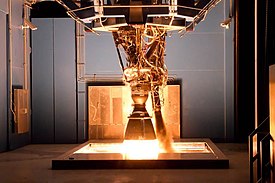
Back محركات ميرلين الصاروخية Arabic Merlin (motor de coet) Catalan Merlin (raketový motor) Czech Merlin (Raketentriebwerk) German Merlín (motor cohete) Spanish مرلین (خانواده موتور موشک) FA Merlin (rakettimoottoriperhe) Finnish Merlin (moteur-fusée) French SpaceX Merlin ID Merlin (motore a razzo) Italian
 Test firing of the Merlin 1D at SpaceX’s McGregor test stand | |
| Country of origin | United States |
|---|---|
| Manufacturer | SpaceX |
| Application |
|
| Associated LV | Falcon 1 · Falcon 9 · Falcon Heavy |
| Status | Active |
| Liquid-fuel engine | |
| Propellant | LOX / RP-1 |
| Cycle | Gas-generator |
| Performance | |
| Thrust, vacuum | 981 kN (221,000 lbf)[1] |
| Thrust, sea-level | 845 kN (190,000 lbf)[1] |
| Thrust-to-weight ratio | 184 |
| Chamber pressure | 9.7 MPa (1,410 psi)[2] |
| Specific impulse, vacuum | 311 s (3.05 km/s)[3] [needs update] |
| Specific impulse, sea-level | 282 s (2.77 km/s)[3] [needs update] |
| Dimensions | |
| Diameter | Sea level: 0.92 m (3.0 ft) Vacuum: 3.3 m (11 ft) |
| Dry mass | 470 kg (1,030 lb)[4] |
Merlin is a family of rocket engines developed by SpaceX. They are currently a part of the Falcon 9 and Falcon Heavy launch vehicles, and were formerly used on the Falcon 1. Merlin engines use RP-1 and liquid oxygen as rocket propellants in a gas-generator power cycle. The Merlin engine was originally designed for sea recovery and reuse, but since 2016 the entire Falcon 9 booster is recovered for reuse by landing vertically on a landing pad using one of its nine Merlin engines.
The injector at the heart of Merlin is of the pintle type that was first used in the Apollo Lunar Module landing engine (LMDE). Propellants are fed by a single-shaft, dual-impeller turbopump. The turbopump also provides high-pressure fluid for the hydraulic actuators, which then recycles into the low-pressure inlet. This eliminates the need for a separate hydraulic drive system and means that thrust vectoring control failure by running out of hydraulic fluid is not possible.
- ^ a b "Falcon User's Guide" (PDF). SpaceX. April 2020. Archived (PDF) from the original on December 2, 2020. Retrieved August 1, 2020.
- ^ Cite error: The named reference
awst20110811was invoked but never defined (see the help page). - ^ a b "Merlin section of Falcon 9 page". SpaceX. Archived from the original on July 15, 2013. Retrieved October 16, 2012.
- ^ Mueller, Thomas (June 8, 2015). "Is SpaceX's Merlin 1D's thrust-to-weight ratio of 150+ believable?". Retrieved July 9, 2015.
The Merlin 1D weighs 1030 pounds, including the hydraulic steering (TVC) actuators. It makes 162,500 pounds of thrust in vacuum. that is nearly 158 thrust/weight. The new full thrust variant weighs the same and makes about 185,500 lbs force in vacuum.